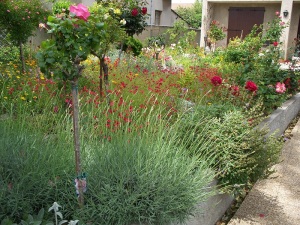
Carcassonne is certainly not lacking in grand examples of beauty: the tree-lined Canal-du-Midi that allows the Atlantic Ocean to connect with the Mediterranean Sea, the River Aude with its source buried deep within the Pyrenees Mountains, and of course the city’s iconic medieval fortress. Sharing the spotlight with those monumental sites are tiny courtyards, safe havens from the winds of winter and the summer sun, hidden all over the city. I have long wanted to live in a home built around an interior courtyard so that each room could benefit from the sun and breezes. It looks like we just got our chance.
For today’s French lesson taken from this post’s title, cour means “courtyard” in English in this context while the similar-looking cœur corresponds to “heart”. For those not reading between the lines, we just bought a house in Carcassonne and all the rooms open onto the courtyard or the heart of our new home.
The process for buying a house here is similar to the United States except in a different order. We initially did our research online at many different real estate agency websites since there’s not one single site that lists everything for sale in your area. If you consult the computerized telephone directory for Carcassonne for companies that sell houses, it tells you that there are 167. Since sellers typically post their homes with the agency in their neighborhood we limited our search to those areas where we wanted to live.

We visited several properties with our agent, finally putting an offer on the courtyard house that was accepted that evening by the seller. One week later we were in the office of the notaire, an attorney who specializes in property law. We signed a stack of papers that in the US would have been presented to us at closing, just prior to receiving the keys. Here, the paperwork is done ahead of time and then the wait of up to 3 months begins. Part of that time is to allow the buyer to arrange financing while 2 months is what the local government gets to evaluate the purchase. The city has first choice on sales in case there is historical or strategic significance to the property. Apparently, even once we own the home, if we find money hidden away we get to keep it but if we’re digging in the backyard and discover a Roman wall, it belongs to the government. New rule: no shovels allowed!
Photo notes: We don’t have any pictures of the house because the selling agent pulled the ad from their website as soon as he returned to the office with our signed offer. This is in contrast to a few other properties we inquired about at other agencies only to be told that they were already sold, yet even today I can still see those listings online. Not to worry; once we’re in we’ll have ample opportunity to take pictures ’cause there’s lots of work to be done.

So happy for you! I hope you’re thinking about turning your blog posts into a book…
LikeLiked by 1 person
Congratulations!
LikeLiked by 1 person
I looked at 96 properties, though that’s just how many are in my spreadsheet–I looked at more before I got so confused I had to devise a way to keep track of the relative advantages/disadvantages of them all. It took over a year to find our apartments.
One place to see a lot of listings is seloger.com. However, it’s a garbage in/garbage out situation where your search results depend on whether the agent has entered the kind of info you’re looking for. Or entered info correctly–I wanted centre ville of Carcassonne, but kept getting listings for villages that weren’t even close.
We are going to have to meet one of these days, Bob! Carcassonne is small enough that we must have passed each other at some point without knowing it. Now that our renovation project is moving along, I have some good artisans to recommend!
LikeLiked by 2 people
I want to wish my son Bill a happy birthday. First time to ever do this for a Frenchman.
LikeLiked by 1 person
Yay! Congratulations!!!
LikeLiked by 1 person
I wanted to be cool and say this in French but chien chaud just doesn’t seem right- so HOT DOG! Cannot wait for pictures!
LikeLiked by 1 person
I can’t wait to see the pictures. I’m so happy you have found your new home.
LikeLiked by 1 person